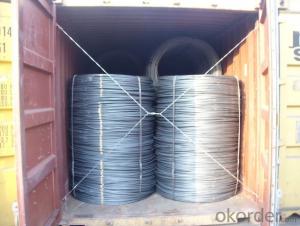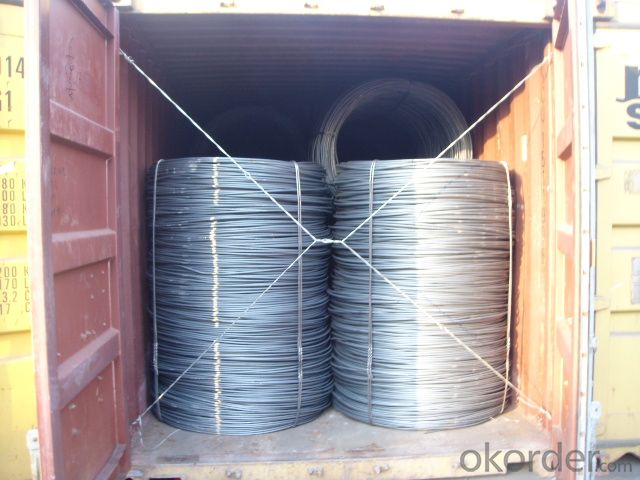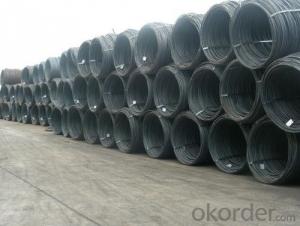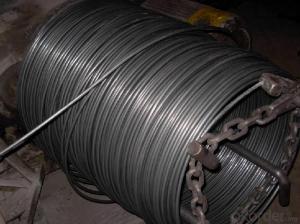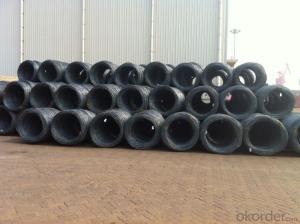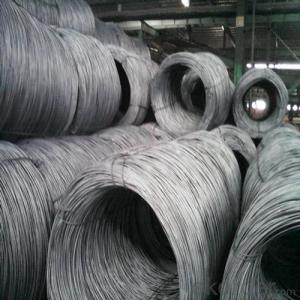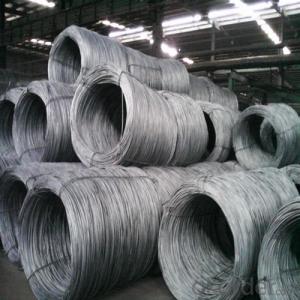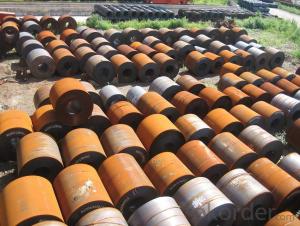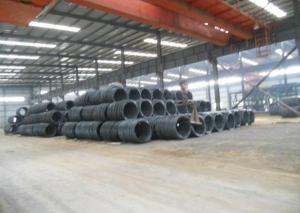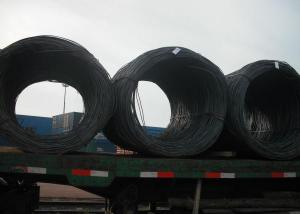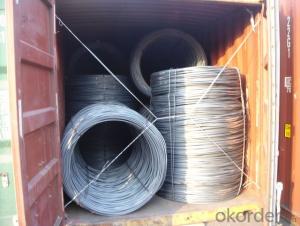GB Q195 Q235 Wire Rod
- Loading Port:
- China Main Port
- Payment Terms:
- TT OR LC
- Min Order Qty:
- -
- Supply Capability:
- -
OKorder Service Pledge
OKorder Financial Service
You Might Also Like
Specifications of Steel Wire Rod in Coil:
Steel Grade: Q195/235, SAE1006-1018B Standard: ASTM, GB
Diameter: 6.5mm
Type: Drawn Wire Alloy or Not: Alloy
Technique: Hot Rolled
Usage and Applications of Hot Rolled Wire Rod:
After hotrolled the products shaped into coil and delivery as finished product, including round, square, rectangular, hexagonal and so on. Since most of the products are round, it is generally called wire rod. Carbon steel wire rod is widely used in construction and manufacturing. Carbon steel wire rod is mainly used for reinforcement of reinforced concrete and welded structure or reprocessed (roberts , nail, etc.) materials, especially used to produce wire drawing, welding electrode, nails, spring, electronic, precise machinery parts and so on.
Packaging & Delivery of Hot Rolled Wire Rod:
Packaging Detail: products are packed in coil, each coil weight around 2 MT, and then shipped by container or bulk vessel
Delivery Detail: within 45 days after received deposit or LC.
Label: to be specified by customer, generally, each bundle has 1-2 labels
Trade terms: FOB, CFR, CIF
Note:
1. Our products are produced according to national standard (GB), if not, supply according to national standards (GB) or agreement as customer required.
2. Other Grade and Standard carbon steel wire rod we can supply:
Grade: H08A, 30MnSi, 62B-82B
Standard: AISI, BS, JIS, DIN
The Minimum Order Quantity of these products is high, and need to be confirmed.
3. We can not only supply carbon steel wire rod; if you need anything about building materials, please contact us.
4. Please send us your detail specifications when inquire. We will reply to you as soon as possible. We sincerely hope we can establish a long stable business relationship.
- Q: What are the common alloys used in steel wire rod production?
- Some common alloys used in steel wire rod production include carbon steel, stainless steel, and low alloy steel.
- Q: What are the common industry exhibitions for steel wire rod?
- Some common industry exhibitions for steel wire rod include Wire & Cable India, Wire China, Wire Southeast Asia, and Wire & Tube Düsseldorf. These exhibitions serve as platforms for manufacturers, suppliers, and professionals in the steel wire rod industry to showcase their products, technologies, and innovations, as well as to network and establish business contacts.
- Q: How is steel wire rod used in the manufacturing of wire forms for ventilation systems?
- Steel wire rod is commonly used in the manufacturing of wire forms for ventilation systems due to its excellent strength and durability. Wire forms are essentially bent or twisted wire components that are used to support and shape various parts of a ventilation system. In the manufacturing process, steel wire rods are first selected based on their specific mechanical properties, such as tensile strength and flexibility, to ensure they can withstand the demanding conditions of a ventilation system. These wire rods are typically made from low carbon steel, which offers a good balance of strength and malleability. The steel wire rods are then processed through a series of steps, including cleaning, hot rolling, and cooling, to shape them into the desired wire form. The rods are first cleaned to remove any impurities or scale that may affect the quality of the final product. They are then hot rolled to reduce their diameter and increase their length, while also improving their mechanical properties. After the hot rolling process, the steel wire rod is cooled and ready to be transformed into wire forms for ventilation systems. Depending on the specific requirements of the system, the wire rod may undergo additional processes such as annealing or surface treatments to enhance its corrosion resistance. Once the steel wire rod has been processed, it is then bent, twisted, or formed into various shapes to create wire forms for ventilation systems. These wire forms can be used for various purposes, such as supporting air ducts, securing filters, or forming grille components. The use of steel wire rod in the manufacturing of wire forms ensures that the resulting components are strong, durable, and capable of withstanding the harsh conditions typically associated with ventilation systems. Steel wire rod's high tensile strength and flexibility make it an ideal material choice for these applications, ensuring that the wire forms can effectively support and shape the ventilation system components for optimal performance and longevity.
- Q: What are the different types of steel wire rod surface defect visualization techniques?
- There are several techniques used for visualizing surface defects in steel wire rods. These include visual inspection, magnetic particle inspection, dye penetrant inspection, eddy current testing, ultrasonic testing, and X-ray inspection. Each technique has its own advantages and limitations, and the choice of technique depends on the specific requirements and characteristics of the steel wire rod being inspected.
- Q: What are the environmental impacts of steel wire rod production?
- The environmental impacts of steel wire rod production include the release of greenhouse gases during the manufacturing process, such as carbon dioxide emissions from the combustion of fossil fuels. Additionally, the extraction and processing of raw materials, such as iron ore and coal, can lead to deforestation, habitat destruction, and air and water pollution. Steel wire rod production also requires significant amounts of energy, contributing to the consumption of non-renewable resources and potentially increasing the use of fossil fuels. Proper waste management and pollution control measures are essential to mitigate these environmental impacts.
- Q: What are the common shaping methods for steel wire rod?
- The common shaping methods for steel wire rod include drawing, rolling, and extrusion.
- Q: How is steel wire rod used in the manufacturing of razor wire?
- Razor wire manufacturing heavily relies on steel wire rod, an indispensable component. This wire rod serves as the main material used to produce the sharp, barbed edges that make razor wire an effective security barrier. To achieve its desired characteristics, the wire rod undergoes a process of being drawn through multiple dies, resulting in reduced diameter and increased tensile strength. Consequently, this process yields a highly durable and flexible wire that can withstand significant tension and pressure. Once the wire rod has undergone the drawing process, it is then twisted or braided to form a helical pattern, thus creating the distinct barbed structure that razor wire is known for. Through this twisting process, sharp and pointed edges are formed along the wire, serving as a deterrent and providing an effective barrier against intruders. In addition to forming the barbed edges, steel wire rod is also employed in connecting the individual barbs, ensuring a coherent and secure structure. Typically, the wire rod is woven or welded between adjacent barbs, guaranteeing that the razor wire maintains its shape and integrity. This interconnecting process significantly improves the overall strength and stability of the razor wire, making it an effective deterrent and obstacle. In conclusion, steel wire rod plays a critical role in the manufacturing of razor wire, providing the necessary strength, flexibility, and sharpness required for an efficient security barrier. Its ability to be drawn, twisted, and connected enables the creation of a formidable and reliable product, widely utilized in military installations, prisons, and high-security areas.
- Q: What are the main factors influencing the choice of steel wire rod transportation method?
- When it comes to selecting the method of transportation for steel wire rods, several key factors come into play. These factors include distance, cost, time, and safety. Distance plays a pivotal role in determining the most suitable mode of transportation. For shorter distances, trucking or rail transport may be the preferred options. On the other hand, for longer distances, sea or air transport may prove to be more efficient. Cost is another critical consideration as it directly impacts the overall transportation expenses. It is essential to take into account the cost of each transportation method, including fuel, labor, and maintenance. Additionally, the cost of any necessary packaging or handling during transportation should also be factored in. Time is of the essence, particularly for time-sensitive deliveries. Different transportation methods have varying transit times, and the urgency of the delivery may influence the choice of transportation. For instance, air transport is generally the fastest option, while sea transport may take longer but could be more cost-effective. Ensuring the safety of the steel wire rods during transportation is paramount. The chosen transportation method should guarantee the security and integrity of the cargo. Factors such as the susceptibility of steel wire rods to damage, the risk of theft, and the stability of the transportation mode should be carefully considered. For instance, if the steel wire rods are fragile or prone to damage, a transportation method with extra protection, such as containerized shipping, may be preferred. Additional factors that may impact the choice of transportation method include environmental considerations, availability of infrastructure, and the reliability of the selected transportation service provider. Ultimately, the selection of the steel wire rod transportation method should be based on a meticulous evaluation of these various factors to ensure the most efficient, cost-effective, and safe transport of the cargo.
- Q: How is the quality of steel wire rod ensured during manufacturing?
- To ensure the quality of steel wire rod during manufacturing, rigorous testing, strict quality control measures, and adherence to industry standards are employed. Firstly, thorough inspection and testing of the raw materials used in production are carried out to ensure they meet the required specifications. This involves testing the chemical composition, physical properties, and metallurgical properties of the raw materials. Throughout the manufacturing process, various quality control measures are implemented to monitor and maintain the quality of the steel wire rod. These measures include regular inspections of production equipment, verification of process parameters, and continuous monitoring of key performance indicators. Moreover, samples of the steel wire rod are taken at different stages of the manufacturing process and subjected to a range of tests to assess their quality. These tests can include dimensional analysis, tensile strength testing, hardness testing, surface quality inspection, and other specialized tests based on specific end-use requirements. Additionally, manufacturing facilities often have a dedicated quality control department that oversees the entire production process and conducts comprehensive quality checks. This department ensures that all quality control procedures and standards are followed and promptly identifies and addresses any deviations or non-conformances. Furthermore, steel wire rod manufacturers must comply with industry standards and certifications, such as ISO 9001, which provide guidelines and best practices for quality management systems. These standards ensure that manufacturing processes are standardized and consistently implemented to maintain the quality of the final product. In conclusion, a combination of strict quality control measures, extensive testing, adherence to industry standards, and continuous monitoring of the production process ensures the quality of steel wire rod. These efforts guarantee that the steel wire rod meets the required specifications and is suitable for its intended applications.
- Q: How is the price of recycled steel wire rod determined?
- The price of recycled steel wire rod is determined by several factors. Firstly, the demand and supply dynamics play a crucial role in determining the price. If there is a high demand for recycled steel wire rod in the market, coupled with a limited supply, the price is likely to increase. Conversely, if the supply exceeds the demand, the price may decrease. Secondly, the quality and grade of the recycled steel wire rod are important factors in price determination. Higher quality rods that meet industry standards and specifications generally command a higher price compared to lower-grade or substandard rods. Additionally, the cost of production and processing also affects the price. Factors such as the cost of collecting and sorting scrap metal, transportation, energy, labor, and other operational expenses are considered in determining the final price of recycled steel wire rod. Furthermore, market conditions and fluctuations in the prices of raw materials and other related commodities can impact the price of recycled steel wire rod. For example, if the price of iron ore (a key raw material in steel production) increases, it can lead to higher production costs, which may be reflected in the price of recycled steel wire rod. Lastly, external factors such as government regulations, trade policies, and environmental considerations can influence the price of recycled steel wire rod. For instance, if there are stricter regulations on carbon emissions or waste management, it may increase the cost of production and subsequently impact the price. In summary, the price of recycled steel wire rod is determined by the demand and supply dynamics, quality and grade, production costs, market conditions, and external factors. Analyzing these factors is essential for understanding and predicting the fluctuations in the price of recycled steel wire rod.
Send your message to us
GB Q195 Q235 Wire Rod
- Loading Port:
- China Main Port
- Payment Terms:
- TT OR LC
- Min Order Qty:
- -
- Supply Capability:
- -
OKorder Service Pledge
OKorder Financial Service
Similar products
Hot products
Hot Searches
Related keywords
